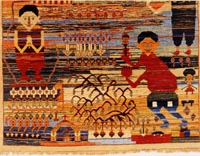Oriental Rugs Today
Art you can sit on
You would think that natural dyed, hand spun, hand-woven carpets from villages in the Mid-East and Asia have disappeared with the caravans, but you’d be wrong. Like the revival of other gourmet goods around the world, traditionally made carpets are in a renaissance. Some experts feel that these contemporary wool carpets exceed the quality of the classic old ones, which command classic antique prices (hundreds of thousands of dollars). At the moment, the new, better ones are far more affordable (and yes, this book deals with the issue of child labor). Fueling the revival of these traditional ways are improved methods of natural dying, and a better market mechanism. You can order some carpets directly on the internet, which passes more money to the weavers. A good hand-woven carpet can last many generations and be used every day. This is art you use — you touch, sit and walk on it. For an overview of the rejuvenation of this wonderfully gorgeous yet utilitarian craft go to this book. It’s the best guide on where they are weaving, what they are making, and where to get them.Excerpts:
We have seen that one of the “revolutionary” aspects of modern rug production has been the return of natural dyes. Not long ago, shoppers who were interested in new rugs (or who couldn’t or wouldn’t spend the money to buy antiques or semi-antiques) had no choice but to buy rugs with synthetic dyes. Today, though, natural dyes are an option in new rugs and, in fact, you will have to decide between natural and synthetic dyes if you buy one. The choice is important because, aside from everything else, natural dyed rugs cost roughly 30 percent more than synthetic-dyed rugs.

For many years, Indian rugs were boring. They’re not boring any more. This detail of a Mahindra rug from Black Mountain Looms is full of fun, and packed with natural dyes.
08/22/03Oriental Rugs Today Emmett Eiland 2000, 199 pages $4+, used






